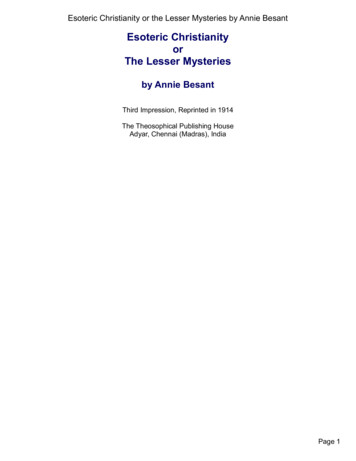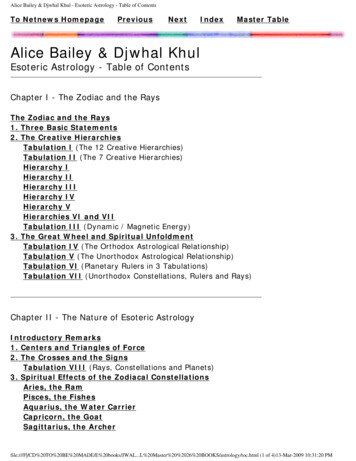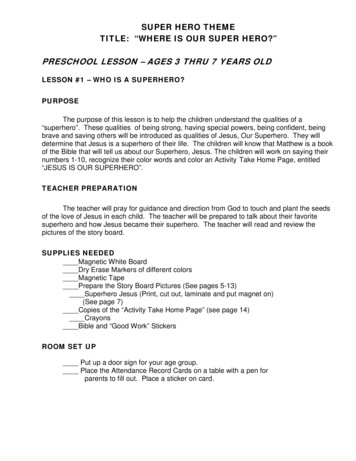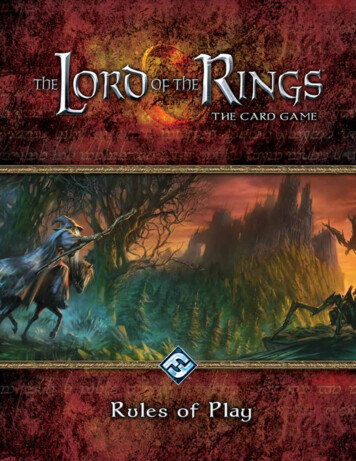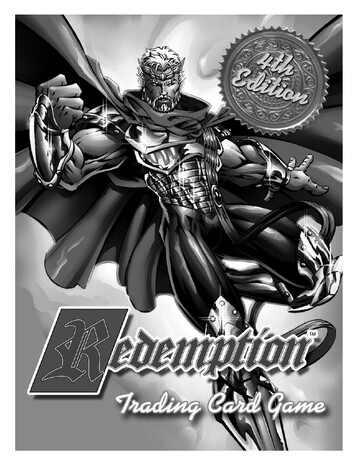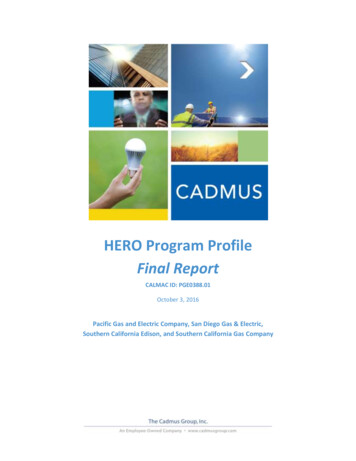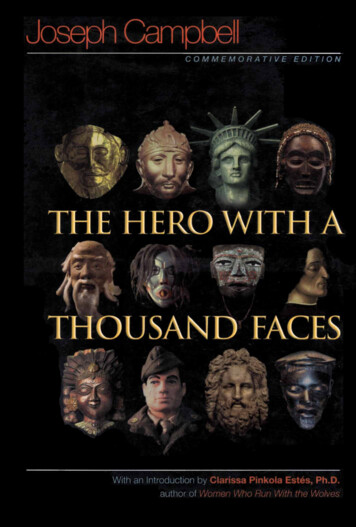
Transcription
Joseph CampbellCOMMEMORATIVEEDITIONTHE HERO WITH AWith an Introduction by Clarissa Pinkola Estes, Ph.D.author of Women Who Run With the Wolves
THE HERO WITH AT H O U S A N D FACESCommemorative Edition, with an Introductionby Clarissa Pinkola Estes, Ph.D.Joseph Campbell's classic crosscultural study of the hero's journeyhas inspired millions and opened upnew areas of research and exploration.Originally published in 1949, thebook hit the New York Times best seller list in 1988 when it became thesubject of The Power of Myth, a PBStelevision special. Now, this legend ary volume, re-released in honor ofthe 100th anniversary of the author'sbirth, promises to capture the imagi nation of a new generation of readers.The first popular work to com bine the spiritual and psychologicalinsights of modern psychoanalysiswith the archetypes of world mythol ogy, the book creates a roadmap fornavigating the frustrating path ofcontemporary life. Examining heroicmyths in the light of modern psychol ogy, it considers not only the patternsand stages of mythology but also itsrelevance to our lives today—and to(continued on back flap)
Ithe life of any person seeking a fullyrealized existence.Myth, according to Campbell, is theprojection of a culture's dreams ontoa large screen; Campbell's book, likeStar Wars, the film it helped inspire,is an exploration of the big-picturemoments from the stage that is ourworld. Offered for the first time withbeautifully restored illustrations anda bibliography of cited works, it pro vides unparalleled insight into world,mythology from diverse cultures. It isa must-have resource for both experi enced students of mythology and theexplorer just beginning to approachmyth as a source of knowledge.JOSEPH CAMPBELL ( 1 9 0 4 1 9 8 7 )wasan inspiring teacher, popular lec turer and author, and the editor andtranslator of many books on mythol ogy, including The Mythic Image(Princeton/Bollingen Paperbacks).CLARISSA PINKOLA E S T E S is theau thor of the national bestseller WomenWho Run with the Wolves.To receive emails about new booksin your area of interest, sign up atpup.princeton.edu
A PRINCETONCLASSICEDITIONTHE HERO WITH ATHOUSAND FACES"I have returned to no book more often since leaving collegethan this one, and every time I discover new insight into the hu man journey. Every generation will find in Hero wisdom for theages."— B I L L MOYERS, host of the PBS television seriesNOW with BUI Moyen"In the three decades since I discovered The Hero with a Thou sand Faces, it has continued to fascinate and inspire me. JosephCampbell peers through centuries and shows us that we are allconnected by a basic need to hear stories and understand our selves. As a book, it is wonderful to read; as illumination into thehuman condition, it is a revelation.—George Lucas, filmmaker, creator of Star Wan"Campbell's words carry extraordinary weight, not ojjjv amo* scholars but among a wide range of other people who fiad h *search down mythological pathways relevant to their lives today*. . . The book for which he is most famous, The Hero with aThousand Faces [is] a brilliant examination, through ancienthero myths, of man's eternal struggle for identity."—TlrtKJacket design by Frank MahoodPRINCETON UNIVERSITY PRESS
BOLLINGENSERIESXVII
THE HERO W I T H ATHOUSANDFACESJOSEPH NANDXVIIPRESSOXFORD
CopyrightPublished 2004 by Princetonby PrincetonUniversityNew Jersey 08540;PressStreet,original edition was copyrightBollingen Foundation,edition (with revisions)UniversityPress, 41 Williamand publishedcopyrightby Pantheon Books; 1968 by PrincetonPrinceton, 1949 bysecondUniversityPressAll rights reservedT H I S V O L U M E IS T H E S E V E N T E E N T H IN A SERIES OF BOOKSS P O N S O R E D BY BOLLINGEN FOUNDATIONFirst Edition,Second Edition,Commemorative19491968Edition,2004T h e Introduction to the 2 0 0 4 edition is copyright 2 0 0 3 Clarissa PinkolaEstes, P h . D . All rights reservedLibraryof Congress Control No.2003066084I S B N : 0-691-11924-4T h i s book has been composed inPrinceton University Press Digital MonticelloPrinted on acid-free paper. »www.pupress.princeton.eduPrinted in the U n i t e d States of America1 3 5 7 9108 6 4 2
TO MTFATHERANDMOTHER
TABLE OF CONTENTSList of FiguresxiList of PlatesxviPreface to the 1949 EditionxxiIntroduction to the 2004 Commemorativeby Clarissa Pinkola Estes, Ph.D.Edition,AcknowledgmentslxviP R O L O G U E : T h e Monomyth1.2.3.4.xxiii1Myth and DreamTragedy and ComedyThe Hero and the GodThe World Navel3232837PART ONET h e A d v e n t u r e of t h e H e r oCHAPTER1.2.3.4.5.I: Departure45The Call to AdventureRefusal of the CallSupernatural AidThe Crossing of the First ThresholdThe Belly of the WhaleII: Initiation1. The Road of Trials2. The Meeting with the Goddess3. Woman as the TemptressCHAPTERvii45546371838989100111
CONTENTS4. Atonement with the Father5. Apotheosis6. The Ultimate BoonIII: ReturnRefusal of the ReturnThe Magic FlightRescue from WithoutThe Crossing of the Return ThresholdMaster of the Two WorldsFreedom to LiveCHAPTER1.2.3.4.5.6.CHAPTERIV: T h e KeysPART TWOT h e C o s m o g o n i e CycleCHAPTER1.2.3.4.5.6.I: EmanationsFrom Psychology to MetaphysicsThe Universal RoundOut of the Void-SpaceWithin Space—LifeThe Breaking of the One into the ManifoldFolk Stories of CreationII: T h e Virgin BirthMother UniverseMatrix of DestinyWomb of RedemptionFolk Stories of Virgin MotherhoodCHAPTER1.2.3.4.III: Transformations of the HeroThe Primordial Hero and the HumanChildhood of the Human HeroThe Hero as WarriorThe Hero as LoverThe Hero as Emperor and as TyrantThe Hero as World RedeemerCHAPTER1.2.3.4.5.6.viii
CONTENTS7. The Hero as Saint8. Departure of the Hero327329CHAPTER I V :Dissolutions1. End of the Microcosm2. End of the Macrocosm337337345E P I L O G U E : Myth and Society1. The Shapeshifter2. The Function of Myth, Cult, and Meditation3. The Hero Today351353354358Bibliography363Index383ix
LIST OF FIGURESSileni and Maenads. From a black-figure amphora,ca. 4 5 0 - 5 0 0 B.C., found in a grave at Gela, Sicily.(Monumenti Antichi, pubblicati per cura dellaReale Accademia dei Lincei, Vol. XVII, Milan,1907, Plate XXXVII.)Minotauromachy.From an Attic red-figure crater,5th cent. B.C. Here Theseus kills the Minotaurwith a short sword; this is the usual version in thevase paintings. In the written accounts the herouses his bare hands. (Collection des vases grecs deM. le Comte de Lamberg, expliquée et publiée parAlexandre de la Borde, Paris, 1813, Plate XXX.)Osiris in the Form of a Bull Transports His Worshiperto the Underworld. From an Egyptian coffin in theBritish Museum. (E. A. Wallis Budge, Osiris andthe Egyptian Resurrection,London, Philip LeeWarner; N e w York, G. P. Putnam's Sons, 1911,Vol. I, p. 13.)Ulysses and the Sirens. From an Attic polychromefigured white lecythus, 5th cent, B.C., now in theCentral Museum, Athens. (Eugénie Sellers,"Three Attic Lekythoi from Eretria," Journal ofHellenic Studies, Vol. XIII, 1892, Plate I.)The Night-Sea Journey:—Joseph in the Well: Entomb ment of Christ: Jonah and the Whale. A page fromthe fifteenth-century Biblia Pauperum,Germanedition, 1471, showing Old Testament prefigurements of the history of Jesus. Compare Figures 8and 11. (Edition of the Weimar Gesellschaft derBibliophilen, 1906.)xi
L I S T OFFIGURES6. Isis in the Form of a Hawk Joins Osiris in the Under world. This is the moment of the conception ofHorus, who is to play an important role in the res urrection of his father. (Compare Fig. 10.) From aseries of bas-reliefs on the walls of the temple ofOsiris at Dendera, illustrating the mysteries per formed annually in that city in honor of the god.(E. A. Wallis Budge, Osiris and the EgyptianResurrection, London, Philip Lee Warner; N e wYork, G. P. Putnam's Sons, 1911, Vol. II, p. 28.)7. Isis Giving Bread and Water to the Soul. (E. A.Wallis Budge, Osiris and the EgyptianResurrec tion, London, Philip Lee Warner; N e w York,G. P. Putnam's Sons, 1911, Vol. II, p. 134.)8. The Conquest of the Monster:—DavidThe Harrowingof Hell: Samson(Same source as Fig. 5.)and Goliath:and the Lion.9a. Gorgon-Sister Pursuing Perseus, Who Is Fleeing withthe Head of Medusa. Perseus, armed with a scimi tar bestowed on him by Hermes, approached thethree Gorgons while they slept, cut off the head ofMedusa, put it in his wallet, and fled on the wingsof his magic sandals. In the literary versions, thehero departs undiscovered, thanks to a cap of in visibility; here, however, we see one of the twosurviving Gorgon-Sisters in pursuit. From a redfigure amphora of the 5th cent. B.C. in the collec tion of the Munich Antiquarium. (Adolf Furtwàngler, Friedrich Hauser, and Karl Reichhold,Griechische Vasenmalerei, Munich, F. Bruckmann,1 9 0 4 - 1 9 3 2 , Plate 134.)9b. Perseus Fleeing with the Head of Medusa in HisWallet. This figure and the one above appear onopposite sides of the same amphora. The effect ofthe arrangement is amusing and lively. (Seexii
L I S T OFFIGURESFurtwàngler, Hauser, and Reichhold, op.Série III, Text, p. 77, Fig. 39.)cit.,18810. The Resurrection of Osiris. T h e god rises from theegg; Isis (the Hawk of Fig. 6) protects it with herwing. Horus (the son conceived in the Sacred Mar riage of Fig. 6) holds the Ankh, or sign of life,before his father's face. From a bas-relief at Philae.(E. A. Wallis Budge, Osiris and the Egyptian Res urrection, London, Philip Lee Warner; N e w York,G. P. Putnam's Sons, 1911, Vol. II, p. 58.)19411. The Reappearance of the Hero:—Samsonwith theTemple-Doors: Christ Arisen: Jonah. (Same sourceas Fig. 5.)20312. The Return of Jason. This is a view of Jason's adven ture not represented in the literary tradition. "Thevase-painter seems to have remembered in someodd haunting way that the dragon-slayer is of thedragon's seed. He is being born anew from hisjaws" (Jane Harrison, Themis, A Study of the SocialOrigins of Greek Religion, Cambridge UniversityPress, second edition, 1927, p. 435). The GoldenFleece is hanging on the tree. Athena, patroness ofheroes, is in attendance with her owl. Note theGorgoneum on her Aegis (compare Plate XXII).(From a vase in the Vatican Etruscan Collection.After a photo by D . Anderson, Rome.)22913. TuamotuanCreation Chart:—Below:The CosmicEgg. Above: The People Appear, and Shape the Uni verse. (Kenneth P. Emory, "The Tuamotuan Cre ation Charts by Paiore," Journal of the PolynesianSociety, Vol. 4 8 , N o . 1, p. 3.)25614. The Separation of Sky and Earth. A common figureon Egyptian coffins and papyri. T h e god ShuHeka separates N u t and Seb. This is the momentof the creation of the world. (F. Max Muller,xiii
L I S T OFFIGURESEgyptian Mythology, T h e Mythology of All Races,Vol. XII, Boston, Marshall Jones Company,1918, p. 4 4 . )26315. Khnemu Shapes Pharaoh's Son on the Potter's Wheel,While Thoth Marks His Span of Life. From a pa pyrus of the Ptolemaic period. (E. A. Wallis Budge,The Gods of the Egyptians, London, Methuen andCo., 1904, Vol. II, p. 50.)27016. Nut (the Sky) Gives Birth to the Sun; Its Rays Fall onHathor in the Horizon (Love and Life). The sphereat the mouth of the goddess represents the sun atevening, about to be swallowed and born anew.(E. A. Wallis Budge, The Gods of the Egyptians,London, Methuen and Co., 1904, Vol. I, p. 101.)27617. Paleolithic Petroglyph (Algiers). From a prehistoricsite in the neighborhood of Tiout. T h e catlike ani mal between the hunter and the ostrich is perhapssome variety of trained hunting panther, and thehorned beast left behind with the hunter's mother,a domesticated animal at pasture. (Leo Frobeniusand Hugo Obermaier, Hâdschra Mâktuba, Munich,K. Wolff, 1925, Vol. II, Plate 78.)31018. King Ten (Egypt, First Dynasty,ca. 3200B.c.)Smashes the Head of a Prisoner of War. From anivory plaque found at Abydos. "Immediately be hind the captive is a standard surmounted by afigure of a jackal, which represents a god, eitherAnubis or Apuat, and thus it is clear that thesacrifice is being made to a god by the king."(E. A. Wallis Budge, Osiris and the Egyptian Res urrection, London, Philip Lee Warner; N e w York,G. P. Putnam's Sons, 1911, Vol. I, p. 197; line cut,p. 207.)31519. Osiris, Judge of the Dead. Behind the god stand thegoddesses Isis and Nephthys. Before him is alotus, or lily, supporting his grandchildren, thexiv
L I S T OFFIGURESfour sons of Horus. Beneath (or beside) him is alake of sacred water, the divine source of the Nileupon earth (the ultimate origin of which is inheaven). T h e god holds in his left hand the flail orwhip, and in his right the crook. T h e corniceabove is ornamented with a row of twenty-eightsacred uraei, each of which supports a disk.—From the Papyrus of Hunefer. (E. A. Wallis Budge,Osiris and the Egyptian Resurrection,London,.Philip Lee Warner; N e w York, G. P. Putnam'sSons, 1911, Vol. I, p. 20.)3412 0 . The Serpent Kheti in the Underworld,Consumingwith Fire an Enemy of Osiris. T h e arms of the vic tim are tied behind him. Seven gods preside. Thisis a detail from a scene representing an area of theUnderworld traversed by the Solar Boat in theeighth hour of the night.—From the so-called"Book of Pylons." (E. A. Wallis Budge, The Godsof the Egyptians, London, Methuen and Co., 1904,Vol. I, p. 193.)34221. The Doubles of Ani and His Wife Drinking Water inthe Other World. From the Papyrus of Ani. (E. A.Wallis Budge, Osiris and the EgyptianResurrec tion, London, Philip Lee Warner; N e w York,G. P. Putnam's Sons, 1911, Vol. II, p. 130.)344xv
LIST OF PLATESFOLLOWINGPAGE84I. The Monster Tamer (Sumer). Shell inlay (perhaps orna menting a harp) from a royal tomb at Ur, ca. 3 2 0 0 B . c .T h e central figure is probably Gilgamesh. (Courtesy ofT h e University Museum, Philadelphia.)II. The Captive Unicorn (France). Detail from tapestry, "TheHunt of the Unicorn," probably made for Francis I ofFrance, ca. 1514 A.D. (Courtesy of The Metropolitan Mu seum of Art, N e w York City.)III. The Mother of the Gods (Nigeria). Odudua, with the infantOgun, god of war and iron, on her knee. The dog is sa cred to Ogun. An attendant, of human stature, plays thedrum. Painted wood. Lagos, Nigeria. Egba-Yoruba tribe.(Horniman Museum, London. Photo from Michael E.Sadler, Arts of West Africa, International Institute ofAfrican Languages and Cultures, Oxford Press, London:Humphrey Milford, 1935.)IV. The Deity in War Dress (Bali). The Lord Krishna in his terrify ing manifestation. (Compare infra, pp. 215-220.) Poly chromatic wooden statue. (Photo from C. M. Pleyte,Indonesian Art, The Hague: Martinus Nijhoff, 1901.)V. Sekhmet, The Goddess (Egypt). Diorite statue. Empire Pe riod. Karnak. (Courtesy of The Metropolitan Museum ofArt, N e w York City.)VI. Medusa (Ancient Rome). Marble, high relief; from the Rondanini Palace, Rome. Date uncertain. (Collection ofthe Glyptothek, Munich. Photo from H. Brunn andF. Bruckmann, Denkmàler griechischer und rômischerSculptur, Verlagsan-stalt fur Kunst und Wissenschaft,Munich, 1 8 8 8 - 1 9 3 2 . )xvi
L I S T OFPLATESVII. The Sorcerer (Paleolithic Cave Painting, French Pyrenees).The earliest known portrait of a medicine man, ca. 10,000B.C. Rock engraving with black paint fill-in, 29.5 incheshigh, dominating a series of several hundred mural engravings of animals; in the Aurignacian-Magdaleniancave known as the "Trois Frères," Ariège, France. (Froma photo by the discoverer, Count Bégouen.)VIII. The Universal Father, Viracocha, Weeping(Argen-tina).Plaque found at Andalgalâ, Catamarca, in northwestArgentina, tentatively identified as the pre-Incan deityViracocha. The head is surmounted by the rayed solardisk, the hands hold thunderbolts, tears descend fromthe eyes. The creatures at the shoulders are perhapsImaymana and Tacapu, the two sons and messengers ofViracocha, in animal form. (Photo from the Proceedingsof the International Congress of Americanists, Vol. XII,Paris, 1902.)FOLLOWINGPAGE180IX. Shiva, Lord of the Cosmic Dance (South India). See discussion, infra, p. 118, note 4 6 . Bronze, 10th-12th cent A . D .(Madras Museum. Photo from Auguste Rodin, AnandaCoomaraswamy, E. B. Havell, Victor Goloubeu, Sculptures Çivaïtes de Vlnde, Ars Asiatica III, Brussels andParis: G. van Oest et Cie., 1921.)X. Androgynous Ancestor (Sudan). W o o d carving from the region of Bandiagara, French Sudan. (Collection of LauraHarden, N e w York City. Photo by Walker Evans, courtesy of The Museum of Modern Art, N e w York City.)XI. Bodhisattva (China). Kwan Yin. Painted wood. Late SungDynasty ( 9 6 0 - 1 2 7 9 A.D.). (Courtesy of The Metropolitan Museum of Art, N e w York City).XII. Bodhisattva (Tibet). The Bodhisattva known as Ushnïshasitâtapatrâ, surrounded by Buddhas and Bodhisattvas,xvii
L I S T OFPLATESand having one hundred and seventeen heads, symboliz ing her influence in the various spheres of being. The lefthand holds the World Umbrella (axis mundi) and theright the Wheel of the Law. Beneath the numerousblessed feet of the Bodhisattva stand the people of theworld who have prayed for Enlightenment, while be neath the feet of the three "furious" powers at the bottomof the picture lie those still tortured by lust, resentment,and delusion. The sun and moon in the upper cornerssymbolize the miracle of the marriage, or identity, ofeternity and time, Nirvana and the world (see pp. 156157 ff.). The lamas at the top center represent the ortho dox line of Tibetan teachers of the doctrine symbolizedin this religious banner-painting. (Courtesy of TheAmerican Museum of Natural History, N e w York City.)XIII. The Branch of Immortal Life (Assyria). Winged being offer ing a branch with pomegranates. Alabaster wall panelfrom the Palace of Ashur-nasir-apal II ( 8 8 5 - 8 6 0 B . C . ) ,King of Assyria, at Kalhu (modern Nimrud). (Courtesyof T h e Metropolitan Museum of Art, N e w York City.)XIV. Bodhisattva(Cambodia).Fragment from the ruins ofAngkor. 12th cent. A . D . The Buddha figure crowningthe head is a characteristic sign of the Bodhisattva(compare Plates XI and XII; in the latter the Buddhafigure sits atop the pyramid of heads). (Musée Guimet,Paris. Photo from Angkor, éditions "Tel," Paris, 1935.)XV. The Return (Ancient Rome). Marble relief found (1887)in a piece of ground formerly belonging to the VillaLudovisi. Perhaps of early Greek workmanship.(Museo délie Terme, Rome. Photo Antike Denkmàler,herausgegeben vom Kaiserlich Deutschen Archaeologischen Institut, Berlin: Georg Reimer, Vol. II, 1908.)XVI. The Cosmic Lion Goddess, Holding the Sun (North India).From a seventeenth- or eighteenth-century single-leafmanuscript, from Delhi. (Courtesy of The PierpontMorgan Library, N e w York City.)xviii
L I S T OFFOLLOWINGPLATESPAGE308XVII. The Fountain of Life (Flanders). Central panel of a trip tych by Jean Bellegambe (of Douai), ca. 1520. T h eassisting female figure at the right, with the littlegalleon on her head, is Hope; the corresponding figureat the left, Love. (Courtesy of the Palais des BeauxArts, Lille.)XVIII. The Moon King and His People (South Rhodesia). Prehis toric rock painting, at Diana V o w Farm, Rusapi Dis trict, South Rhodesia, perhaps associated with thelegend of Mwuetsi, the Moon Man (infra, pp.2 7 9 - 2 8 2 ) . The lifted right hand of the great recliningfigure holds a horn. Tentatively dated by its discov erer, Leo Frobenius, ca. 1500 B.C. (Courtesy of theFrobenius-Institut, Frankfurt-am-Main.)XIX. The Mother of the Gods (Mexico). Ixciuna, giving birth toa deity. Statuette of semi-precious stone (scapolite, 7.5inches high). (Photo, after Hamy, courtesy of T h eAmerican Museum of Natural History, N e w York City.)XX. Tangaroâ, Producing Gods and Men (RurutuIsland).Polynesian wood carving from the Tubuai (Austral)Group of Islands in the South Pacific. (Courtesy ofThe British Museum.)XXI. Chaos Monster and Sun God (Assyria). Alabaster wallpanel from the Palace of Ashur-nasir-apal II ( 8 8 5 8 6 0 B.C.), King of Assyria, at Kalhu (modern Nimrud).The god is perhaps the national deity, Assur, in therole played formerly by Marduk of Babylon (see pp.2 6 3 - 2 6 5 ) and still earlier by Enlil, a Sumerian stormgod. (Photo from an engraving in Austen Henry Layard, Monuments of Nineveh, Second Series, London:J. Murray, 1853. The original slab, now in The BritishMuseum, is so damaged that the forms can hardly bedistinguished in a photograph. The style is the sameas that of Plate XIII.)xix
L I S T OFPLATESXXII. The Young Corn God (Honduras). Fragment in lime stone, from the ancient Mayan city of Copan. (Cour tesy of T h e American Museum of Natural History,N e w York City.)XXIII. The Chariot of the Moon (Cambodia). Relief at AngkorVat. 12th cent. A.D. (Photo from Angkor, éditions "Tel,"Paris, 1935.)XXIV. Autumn (Alaska). Eskimo dance mask. Painted wood.From the Kuskokwim River district in southwestAlaska. (Courtesy of The American Indian Heye Foun dation, N e w York City.)XX
PREFACE TO THE 1949 EDITIONcontained in religious doctrines are after all sodistorted and systematically disguised," writes Sigmund Freud,"that the mass of humanity cannot recognize them as truth. T h ecase is similar to what happens when we tell a child that new born babies are brought by the stork. Here, too, we are tellingthe truth in symbolic clothing, for we know what the large birdsignifies. But the child does not know it. He hears only the dis torted part of what we say, and feels that he has been deceived;and we know how often his distrust of the grown-ups and his re fractoriness actually take their start from this impression. W ehave become convinced that it is better to avoid such symbolicdisguisings of the truth in what we tell children and not to with hold from them a knowledge of the true state of affairs commen surate with their intellectual level."It is the purpose of the present book to uncover some of thetruths disguised for us under the figures of religion and mythol ogy by bringing together a multitude of not-too-difficult exam ples and letting the ancient meaning become apparent of itself.The old teachers knew what they were saying. Once we havelearned to read again their symbolic language, it requires nomore than the talent of an anthologist to let their teaching beheard. But first we must learn the grammar of the symbols, andas a key to this mystery I know of no better modern tool thanpsychoanalysis. Without regarding this as the last word on thesubject, one can nevertheless permit it to serve as an approach.The second step will be then to bring together a host of myths andfolk tales from every corner of the world, and to let the symbols" T H E TRUTHS11Sigmund Freud, The Future of an Illusion (translated by James Stracheyet al., Standard Edition, X X I ; London: T h e Hogarth Press, 1961), pp. 4 4 - 4 5(Orig. 1927.)xxi
P R E F A C E TO T H E 1949EDITIONspeak for themselves. The parallels will be immediately appar ent; and these will develop a vast and amazingly constant state ment of the basic truths by which man has lived throughout themillenniums of his residence on the planet.Perhaps it will be objected that in bringing out the correspon dences I have overlooked the differences between the variousOriental and Occidental, modern, ancient, and primitive tradi tions. T h e same objection might be brought, however, againstany textbook or chart of anatomy, where the physiological varia tions of race are disregarded in the interest of a basic generalunderstanding of the human physique. There are of coursedifferences between the numerous mythologies and religions ofmankind, but this is a book about the similarities; and oncethese are understood the differences will be found to be muchless great than is popularly (and politically) supposed. My hopeis that a comparative elucidation may contribute to the perhapsnot-quite-desperate cause of those forces that are working in thepresent world for unification, not in the name of some ecclesias tical or political empire, but in the sense of human mutual un derstanding. As we are told in the Vedas: "Truth is one, thesages speak of it by many names."For help in the long task of bringing my materials into read able form, I wish to thank Mr. Henry Morton Robinson, whoseadvice greatly assisted me in the first and final stages of thework, Mrs. Peter Geiger, Mrs. Margaret W i n g , and Mrs. HelenMcMaster, who went over the manuscripts many times andoffered invaluable suggestions, and my wife, who has workedwith me from first to last, listening, reading, and revising.J. C.New York CityJune 10, 1948xxii
INTRODUCTION TO THE 2 0 0 4COMMEMORATIVE EDITIONWhat Does the Soul Want?. . . MYTH IS THE SECRET OPENING THROUGH WHICH THEINEXHAUSTIBLE ENERGIES OF THE COSMOS POUR INTOHUMAN CULTURAL MANIFESTATION. . . .—Joseph CampbellAPreambleI AM H O N O R E D to be invited to write this introduction to the workof a soul I have regarded in many ways for so long. The contextand substance of Joseph Campbell's lifework is one of the most re cent diamonds on a long, long necklace of other dazzling gemstones that have been mined by humanity—from the depths, andoften at great cost—since the beginning of time. There is no doubtthat there is strung across the eons—a strong and fiery-wroughtchain of lights, and that each glint and ray represents a greatwork, a great wisdom preserved. The lights on this infinite liga ture have been added to, and continue to be added to, link by link.A few of the names of those who have added such lights arestill remembered, but the names of those who ignited most ofthe lights have been lost in time. However, it can be said that weare descended from them all. This phenomenon of the necklaceof lights should not be understood as some mere trinket. Its real ity is that it has acted, since forever, as a swaying, glowing life line for human souls trying to find their ways through the dark.Joseph Campbell was born in 1904, and his work continues toattract the interested reader, the experienced seeker, and theneophyte as well, for it is written with serious-mindedness andxxiii
I N T R O D U C T I O N TO T H E 2004 E D I T I O Nsuch brio, and so little mire. The Hero with a Thousand Faces isabout the heroic journey, but it is not written, as some works onthe subject are, by a mere onlooker. It is not written by one sim ply hyper-fascinated with mythos, or by one who bowdlerizesthe mythic motifs so that they no longer have any electrical pulseto them.N o , this work is authored by a genuinely inspirited personwho himself was once a novice, that is, a beginner who openednot just the mind, but also the longing heart, all in order to be avessel for spiritual realities—ones greater than the conclusions ofthe ego alone. Over time, Campbell became to many people anexample of what it means to be a master teacher. While grantingmerit to the pragmatic, he also carried the sensibilities of a mod ern mystic—and even in old age, a time during which many mayfeel they have earned the right to be irritable and remote,Campbell continued to be intensely capable of awe and wonder.In The Hero with a Thousand Faces, via numerous myths, heshows how the heroic self seeks an exacting spiritual counte nance, that is, a higher way of holding and conducting oneself.This heroic way offers depth of insight and meaning. It is atten tive to guides along the way, and invigorates creative life. W esee that the journey of the hero and heroine are most often deep ened via ongoing perils. These include losing one's way innu merable times, refusing the first call, thinking it is only onething when it really is, in fact, quite another—as well as entangle ments and confrontations with something of great and oftenfrightening magnitude. Campbell points out that coming throughsuch struggles causes the person to be infused with more vision,and to be strengthened by the spiritual life principle—which,more than anything else, encourages one to take courage to livewith effrontery and mettle.Throughout his work too, time and again, he does not offerpap about the mediocre, timid, or tired ruts of spiritual life. In stead, he describes the frontiers of spiritual matters as he envi sions them. One can see in the tales he chooses to tell that heknows a heroic endeavor draws a person into timeless time.There, the intents and contents of spirit, soul, and psyche arexxiv
I N T R O D U C T I O N TO T H E 2 0 0 4EDITIONnot logged according to artificial stops normally assigned to mun dane time. N o w life is measured instead by the depth of longingto remember one's own wholeness, and by the crackle of efforts tofind and keep alive the most daring and undiminished heart.In the oldest myths from Babylonia, Assyria, and other ancientpopulations, the storytellers and poets, who pecked with styluseson stone or etched with pigment on hand-wrought paper orcloth, beautifully detailed a particular idea about psychic reso nance—one that modern psychoanalysts, mythologists, theolo gians, and artists also continue to take up with interest. Thisvery old idea about mythic reverberation was understood as onewhich takes place in a triad between Creator, individual humanbeing, and the larger culture. Each mysteriously and deeplyaffects and inspires the others.Thus, in a number of ancient Babylonian and Assyrian tales,the psychological, moral, and spiritual states of the heroic char acter, of the king or queen, were directly reflected in the healthof the people, the land, the creatures, and the weather. W h e nthe ruler was ethical and whole, the culture was also. W h e n theking or queen was ill from having broken taboos, or had becomesick with power, greed, hatred, sloth, envy, and other ailments,then the land fell into a famine. Insects and reptiles rained downfrom the skies. People weakened and died. Everyone turned onone another, and nothing new could be born.Campbell brings this ancient idea into his work too. Borrow ing the term monomyth, a word he identifies as on
THE HERO WITH A THOUSAND FACES Commemorative Edition, with an Introduction by Clarissa Pinkola Estes, Ph.D. Joseph Campbell's classic cross-cultural study of the hero's journey has inspired millions and opened up new areas of research and exploration. Originally published in 1949, the book hit the New York Times best



